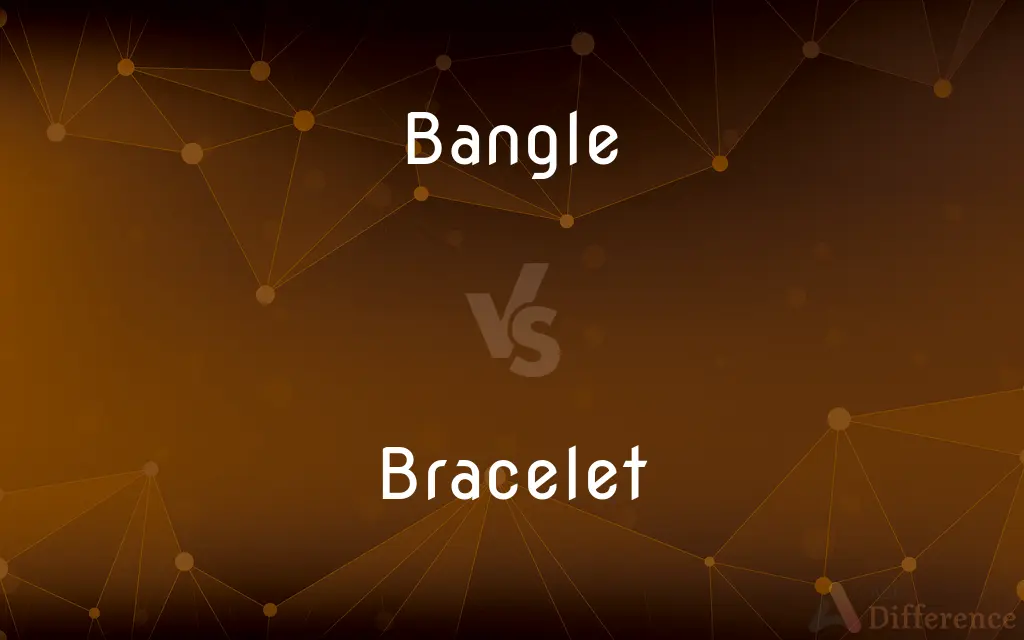Bangle vs. Bracelet — What's the Difference?
Edited by Tayyaba Rehman — By Maham Liaqat — Updated on April 22, 2024
Bangles are rigid, circular jewelry pieces worn around the wrist, typically slipping over the hand, whereas bracelets are more flexible, often featuring a clasp and available in various shapes and designs.

Difference Between Bangle and Bracelet
Table of Contents
ADVERTISEMENT
Key Differences
Bangles are traditionally rigid and do not bend, making them slip over the hand onto the wrist. On the other hand, bracelets are flexible, crafted with linked elements or chains and often secured with a clasp.
Bangles can be made of various materials like gold, silver, glass, or plastic and are usually worn in multiples for a clanging sound. Whereas bracelets can be made from a wider range of materials including beads, metals, leather, and textiles, often adorned with charms or jewels.
The cultural significance of bangles is pronounced in many South Asian cultures, where they symbolize marital status or certain rites of passage. In contrast, bracelets are used globally without specific cultural implications and are often worn as fashion statements or personal ornaments.
In terms of design, bangles are usually simple and uniform in shape but can have intricate carvings or inlays. Bracelets, however, can vary greatly in design, incorporating adjustable features, various patterns, and personalized elements.
From a historical perspective, bangles have ancient origins, being found in archaeological digs dating back thousands of years. Bracelets also have a long history but have evolved significantly in terms of style and functionality, reflecting broader fashion trends over time.
ADVERTISEMENT
Comparison Chart
Flexibility
Rigid, does not bend
Flexible, often features a clasp
Materials
Gold, silver, glass, plastic
Metals, beads, leather, textiles
Cultural Significance
High in South Asian cultures
Widespread, with no specific cultural implications
Design
Uniform shape, may have intricate designs
Highly variable designs, adjustable
Historical Use
Ancient origins, less variation over time
Ancient but evolved in style and function
Compare with Definitions
Bangle
Made from a variety of materials including glass.
The colorful glass bangles are popular at traditional festivals.
Bracelet
Often adorned with jewels or charms for personalization.
Her bracelet jingled with charms collected from her travels.
Bangle
A rigid piece of jewelry worn around the wrist.
She wore several gold bangles that jingled as she moved.
Bracelet
Used as fashion accessories or for sentimental reasons.
The bracelet bore her initials and those of her spouse.
Bangle
Often circular and slips over the hand without a clasp.
Her silver bangle was adorned with traditional carvings.
Bracelet
A flexible piece of jewelry that wraps around the wrist.
He wore a leather bracelet with a custom-engraved charm.
Bangle
Worn in sets to create a musical effect when moving.
The dancer’s movements were accentuated by the clanging of her bangles.
Bracelet
Can feature a clasp or be a stretchy, slip-on accessory.
Her bracelet clasped with a small hook and eyelet.
Bangle
Common in many cultures as a symbol of marital status.
In her culture, the number of bangles on her wrist signified her marital happiness.
Bracelet
Versatile in design, suitable for both casual and formal wear.
She chose a simple, elegant bracelet to complement her evening gown.
Bangle
Bangles are traditionally rigid bracelets which are usually made of metal, wood, glass or plastic. These ornaments are worn mostly by women in Indian Subcontinent, Southeastern Asia and Africa.
Bracelet
A bracelet is an article of jewellery that is worn around the wrist. Bracelets may serve different uses, such as being worn as an ornament.
Bangle
A rigid ornamental band worn round the arm or occasionally the ankle
She rubbed the ivory bangle on her wrist
Bracelet
An ornamental band or chain encircling the wrist or arm.
Bangle
A rigid bracelet or anklet, especially one with no clasp.
Bracelet
Something, such as a handcuff, that resembles a wrist ornament.
Bangle
An ornament that hangs from a bracelet or necklace.
Bracelet
A band or chain worn around the wrist as jewelry/jewellery or an ornament.
Bangle
A rigid bracelet or anklet, especially one with no clasp.
Bracelet
The strap of a wristwatch, used to secure it around the wrist.
Bangle
(dialectal) The cut branch of a tree; a large, rough stick; the largest piece of wood in a bundle of twigs
Bracelet
(historical) A piece of defensive armour for the arm.
Bangle
To beat about or beat down, as corn by the wind.
Bracelet
(transitive) To surround with, or as if with, a bracelet; to ring or encompass.
Bangle
To waste away little by little; squander carelessly; fritter (away).
If we bangle away the legacy of peace left us by Christ, it is a sign of our want of regard for him. — Duty of Man.
Bracelet
An ornamental band or ring, for the wrist or the arm; in modern times, an ornament encircling the wrist, worn by women or girls.
Bangle
(intransitive) (falconry) to beat about in the air; flutter: said of a hawk which does not rise steadily and then swoop down upon its prey.
Bracelet
A piece of defensive armor for the arm.
Bangle
(intransitive) to flap or hang down loosely, as a hat brim or an animal's ear.
Bracelet
A band of cloth or leather or metal links attached to a wristwatch and wrapped around the wrist
Bangle
To waste by little and little; to fritter away.
Bracelet
Jewelry worn around the wrist for decoration
Bangle
An ornamental circlet, of glass, gold, silver, or other material, worn mostly by women, upon the wrist or ankle; a ring bracelet. It differs from other bracelets in being rigid and not articulated, in contrast to bracelets made of links.
Bangle
Jewelry worn around the wrist for decoration
Bangle
Cheap showy jewelry or ornament on clothing
Common Curiosities
How does a bracelet differ from a bangle?
Bracelets are flexible and often feature clasps, while bangles are rigid and usually slip over the hand.
Why are bangles significant in South Asian cultures?
Bangles in South Asian cultures often symbolize marital status or are important in other rites of passage.
Can bangles be adjusted for size?
Typically, bangles are not adjustable due to their rigid nature, though some designs may offer slight adjustments.
Can men wear bangles and bracelets?
Absolutely, both bangles and bracelets are worn by men, especially as fashion statements.
What is a bangle?
A bangle is a rigid, circular piece of jewelry typically worn around the wrist.
How do bangles fit into traditional wedding attire?
In many cultures, especially South Asian, bangles are an essential part of wedding attire, symbolizing luck and prosperity.
What materials are commonly used to make bracelets?
Bracelets can be made from metals, leather, textiles, beads, and more, often decorated with additional elements like charms or jewels.
Are bracelets suitable for all age groups?
Yes, bracelets are versatile and can be designed to suit any age, style, or occasion.
Are there any health benefits to wearing bangles or bracelets?
While generally worn for aesthetic purposes, some believe that wearing bangles made of certain metals can have health benefits.
What are the trends in bracelet designs today?
Current trends include stacking multiple bracelets, incorporating mixed materials, and personalized charms.
How can one authenticate the material of a bangle or bracelet?
Authentication can involve checking hallmarks, seeking appraisals, and purchasing from reputable dealers.
How do you choose between a bangle and a bracelet?
The choice might depend on personal style, comfort, and the occasion for which the jewelry is intended.
What is the best way to store bangles and bracelets?
They should be stored separately to avoid scratches, ideally on a jewelry stand or in a lined jewelry box.
What are some popular bracelet styles for formal events?
For formal wear, sleek, elegant designs often featuring precious metals and stones are popular.
How can one mix and match bangles and bracelets?
Mixing different materials and styles can create a unique and personalized look, balancing texture and color.
Share Your Discovery

Previous Comparison
Impressionism vs. Postimpressionism
Next Comparison
Decree vs. DeclarationAuthor Spotlight
Written by
Maham LiaqatEdited by
Tayyaba RehmanTayyaba Rehman is a distinguished writer, currently serving as a primary contributor to askdifference.com. As a researcher in semantics and etymology, Tayyaba's passion for the complexity of languages and their distinctions has found a perfect home on the platform. Tayyaba delves into the intricacies of language, distinguishing between commonly confused words and phrases, thereby providing clarity for readers worldwide.
















































